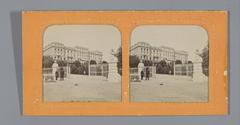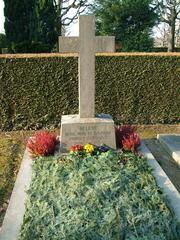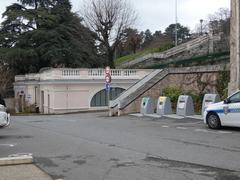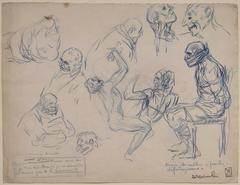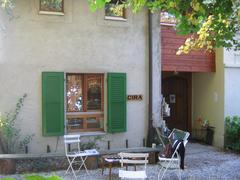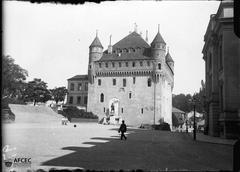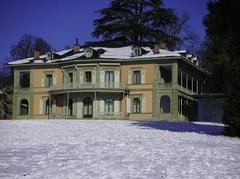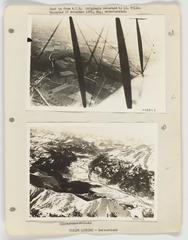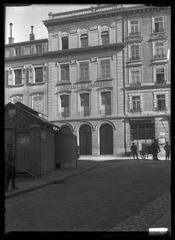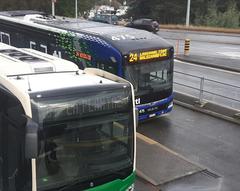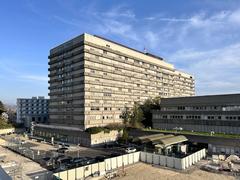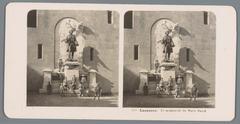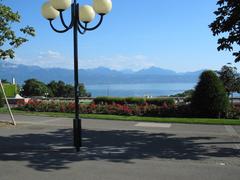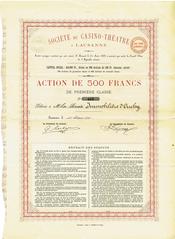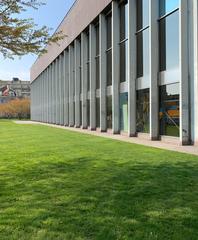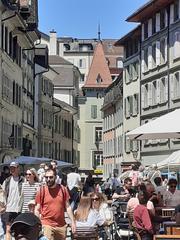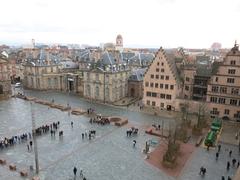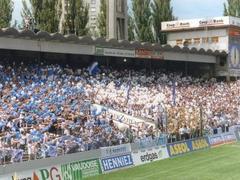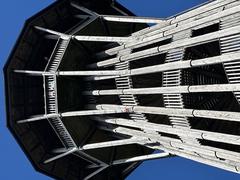
Tour de Bel-Air Visiting Hours, Tickets, and Historical Site Guide in Lausanne
Date: 04/07/2025
Introduction
The Tour de Bel-Air in Lausanne, Switzerland, is more than just a striking high-rise—it is a landmark of Swiss modernism and a testament to the city’s evolution into a vibrant urban center. Built in the early 1930s, the tower marked Lausanne’s embrace of modern architectural innovation, reflecting both American skyscraper influence and European design sensibilities. Today, it stands as a symbol of Lausanne’s urban identity, offering a unique blend of historical significance, architectural interest, and community engagement. This detailed guide covers the history, design, visiting information, accessibility, and highlights of the Tour de Bel-Air, ensuring you make the most of your visit to this iconic monument.
Table of Contents
- Historical Overview
- Visiting the Tour de Bel-Air
- Architectural Features
- Events and Seasonal Highlights
- Nearby Attractions
- Preservation and Legacy
- Visitor FAQs
- Essential Information
- Conclusion and Recommendations
- References and Useful Links
Historical Overview
Origins and Conception
The Tour de Bel-Air emerged during a period of rapid urbanization and architectural innovation across Switzerland and Europe. Zurich developer Eugen Scotoni acquired the plot at Place Bel-Air in the late 1920s, envisioning a multifunctional complex for Lausanne’s city center. Although Eugène Jost initially contributed to the project’s conceptual development, the design commission ultimately went to the renowned Swiss architect Alphonse Laverrière (modernism-in-architecture.org).
Construction and Design
Completed in 1932, the Tour de Bel-Air was Switzerland’s first skyscraper, boldly redefining Lausanne’s skyline. The structure features a reinforced concrete frame—a modern engineering feat at the time—rising 53 meters from Place Bel-Air (68 meters from Rue de Genève due to the terrain). The tower’s horseshoe-shaped layout harmonizes with the local topography and urban context. Its restrained, classicist façade, symmetrical windows, and greenish Art Deco glass blocks at the north entrance demonstrate a sophisticated blend of function and elegance. A 12-meter flagpole atop the building is a distinctive finishing touch (espazium.ch; petitfute.com).
Cultural Impact
The Tour de Bel-Air’s modernist style initially provoked debate, with critics fearing it would overshadow Lausanne’s historic Notre Dame Cathedral and disrupt the city’s traditional skyline. However, it soon became a symbol of progress, offering multifunctional spaces for offices, shops, and the renowned Salle Métropole cinema-theater. Its prominence in local iconography and city life underscores its importance as both an architectural and cultural landmark (modernism-in-architecture.org; espazium.ch).
Visiting the Tour de Bel-Air
Visiting Hours & Ticketing
- Exterior Viewing: The Tour de Bel-Air’s exterior and the surrounding Plaza Bel-Air are accessible to the public year-round, 24/7. There is no admission fee to view or photograph the tower from outside.
- Interior Access: The building is primarily used for commercial offices, so the general public cannot enter the tower itself.
- Salle Métropole Cinema: Events inside the cinema—the complex’s main public venue—run Monday to Friday 10:00 AM–10:00 PM, Saturday 12:00 PM–10:00 PM, and are closed on Sundays. Tickets for events can be purchased online or at the venue, usually ranging from CHF 12–18 (Métropole cinema official website).
Accessibility
The area around Tour de Bel-Air is fully accessible for visitors with reduced mobility. Public transportation options are excellent, with bus and metro lines (M1, M2) stopping at Place Bel-Air. The Lausanne railway station is about a 10-minute walk away. Parking is available at nearby public garages but can be limited during busy periods; public transport is recommended.
Guided Tours and Photography
While guided tours inside the tower are rare, several architectural walking tours offered by the Lausanne tourism office and local guides include the Tour de Bel-Air as a highlight. Self-guided digital tours are also available (lausanne-tourisme.ch). The tower’s vertical silhouette and Art Deco details make it a rewarding subject for photography, especially from Place Bel-Air or Rue de Genève.
Architectural Features
Stylistic Influences
The Tour de Bel-Air is often cited as Lausanne’s first true “skyscraper,” taking inspiration from American high-rise models while adhering to European modernist ideals. Its reinforced concrete frame and vertical emphasis reflect the engineering ambitions of early 20th-century architecture. However, unlike many American skyscrapers with expressive façades, the Tour de Bel-Air’s exterior is more subdued, with clean lines and minimal ornamentation, balancing modernity with contextual sensitivity (espazium.ch).
Urban Integration
Strategically located at Place Bel-Air, the tower integrates harmoniously into Lausanne’s cityscape, serving as a central orientation point and adjacent to major transport, shopping, and cultural hubs. Its presence bridges the city’s medieval heritage with its modern ambitions, underscoring Lausanne’s evolution as a dynamic urban center (Explorial; Lausanne Tourisme).
Events and Seasonal Highlights
Winter Light Projections
Each winter, Tour de Bel-Air becomes the centerpiece of Lausanne’s festive illuminations. From late November through early January, the tower’s façade hosts a vibrant projection mapping event celebrating themes such as biodiversity and local parks. The 2024–2025 edition will run nightly from 17:30, with looped shows lasting about 30 minutes. The festive atmosphere extends to surrounding markets and events, offering food, music, and artisanal products (Lausanne Noël Animations; lausanne-tourisme.ch).
Tips for Visitors:
- Arrive early for a good spot, especially on weekends.
- Dress warmly for outdoor events.
- The event is free and accessible; public transport is recommended.
Nearby Attractions
Combine your visit to Tour de Bel-Air with these notable Lausanne sites:
- Notre Dame Cathedral: A masterpiece of Gothic architecture, just a short walk away.
- Olympic Museum: Dedicated to the Olympic movement, located lakeside.
- Lausanne Old Town: Explore picturesque streets, cafés, and museums.
- Flon District: Offers shopping, dining, and nightlife options.
- Parc de Mon Repos: A tranquil park ideal for relaxation.
For more, see the Lausanne Tourisme City Centre Guide.
Preservation and Legacy
Recognized as a Swiss cultural property of national significance since 1992, the Tour de Bel-Air has been subject to careful preservation. Notable renovations (including those led by CCHE in 2016) have ensured that the tower retains its historical character while serving contemporary urban needs. Public campaigns have also played a key role in the preservation of its iconic elements, such as the Métropole cinema (modernism-in-architecture.org; espazium.ch).
Visitor FAQs
Q: Can I visit the interior of the Tour de Bel-Air?
A: Generally, no. The interior is reserved for commercial use, but public events at the Salle Métropole cinema are accessible.
Q: Is there an entrance fee?
A: No fee for exterior viewing or seasonal light projections. Cinema events are ticketed.
Q: Is the area accessible for those with disabilities?
A: Yes, the site and surrounding plaza are wheelchair accessible.
Q: Are guided tours available?
A: Yes, several walking tours include the tower. Check with Lausanne Tourisme for current offerings.
Q: What’s the best time to visit?
A: Any time for exterior viewing; evenings during winter for festive light shows.
Essential Information
- Address: Place Bel-Air, 1003 Lausanne, Switzerland
- Public Transport: Metro M1/M2 (Lausanne-Flon/Lausanne-Gare), several bus lines
- Events: Winter projection mapping from November 20, 2024, to early January 2025
- Admission: Free for outdoor viewing; tickets required for cinema events and purchases at markets
- Accessibility: Wheelchair accessible; public restrooms and information points nearby
For up-to-date details, consult the City of Lausanne’s official website.
Conclusion and Recommendations
The Tour de Bel-Air is a testament to Lausanne’s pioneering spirit and architectural ambition. From its roots as a controversial skyscraper to its present status as a cherished city landmark, the tower encapsulates the interplay between heritage and innovation. Whether you’re drawn by its history, design, or festive illuminations, a visit to the Tour de Bel-Air is an enriching experience that connects you to the heart of Lausanne.
For guided audio tours and exclusive content, download the Audiala app. Explore related posts on Swiss architecture and Lausanne’s historical sites, and follow local tourism channels on social media for the latest updates. Share your experience using #TourdeBelAirLausanne!
References and Useful Links
- Tour de Bel-Air in Lausanne: History, Visiting Hours, Tickets, and What to See at This Iconic Swiss Landmark
- Tour de Bel-Air Visiting Hours and Architectural Significance: A Guide to Lausanne’s Historic Skyscraper
- La Tour Bel-Air Lausanne: History, Visiting Hours, and Cultural Significance
- Tour de Bel-Air Visiting Hours, Tickets, and Visitor Information: Exploring Lausanne’s Historic Landmark
- Lausanne Tourism Official Site


